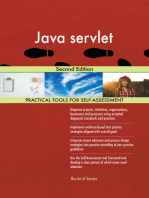Stable/Patient Sort: Bit-Manipulation-To-Solve-Problems-Easily-And-Efficiently
Uploaded by
mmjonStable/Patient Sort: Bit-Manipulation-To-Solve-Problems-Easily-And-Efficiently
Uploaded by
mmjonLagrange’s Four-Square Theorem
- Any number can be represented as a sum of 4 squares, meaning we can have 1, 2, 3, or
4 squares
- Check if 1 square: if int(sqrt(x)) == x: return True
- Check if 2 squares:
o Iterate over the square roots from i up to sqrt(x), then check if the leftover
value (x – i*i) is a perfect square or not
- Check if 4 squares: If this value is not of the form 4^k(8m+7)
- Check if 3 squares: if it is not any of these, then it is 3 squares
- If we do not know about the 4^k(8m+7) formula, then we need to check all pairs i,j <
sqrt(x) so n=i*i +j*j + k*k with complexity O(n) and same for 4
Sum of two squares theorem
- Any number greater than 1 can be written as a sum of two squares n=a^2 + b^2 for
some integers a,b iff its prime decomposition contains no prime congruent to 3 % 4
raised to an odd power
Ex. 2450 = 2 · 52 · 72
- 7 is congruent to 3 % 4 but is raised to 2 which is even so it does have a sum of two
squares which is 7^2 + 49^2
Sum of N numbers starting from 1
N * (N+1) / 2
Sorting Algorithms
Stable/Patient Sort
Create new piles when there is larger number than the other piles. This results in
increasing sequences and is good for largest increasing sequence.
Bit Manipulation
https://leetcode.com/problems/sum-of-two-integers/discuss/84278/A-summary%3A-how-to-use-
bit-manipulation-to-solve-problems-easily-and-efficiently
what is topological sort? Kahns algorithm to
Digital Root
- This is if you have a digit (e.g. 38 or 193), and you sum all the digits iteratively until the
value is a single digit (e.g. 3 + 8 = 11, 1 + 9 + 3 = 13). You can do this in O(1) Time and
Space using the digital root formula without any loop or recursion
"""
check parity (odd or even): & 1
get last bit: x & (x-1)
two complement : res = -(1<<32 - res)
- get the value of a negative bit representation
- we convert it to a value 1<<32, then we need to subtract to get the complement
"""
Negative bit value: the complement of the bit except the last 1 stays 1 bit
5: 0000000000000101
-5: 1111111111111011
8: 0000000000001000
-8: 1111111111111000
12: 0000000000001100
-12: 1111111111110100
Subsequence vs Substring
Subarray: contiguous sequence in an array
Subsequence: Need not to be contiguous, but maintains order
Subset: keeps relative order but does not need to be contiguous
You might also like
- OSCP - 2022 - Standalones - October - 19 MachinesNo ratings yetOSCP - 2022 - Standalones - October - 19 Machines32 pages
- Apache Cassandra Administrator Associate - Exam Practice TestsFrom EverandApache Cassandra Administrator Associate - Exam Practice TestsNo ratings yet
- Design and Analysis of Electric Vehicle Gearbox and Differential100% (1)Design and Analysis of Electric Vehicle Gearbox and Differential8 pages
- Syndicate 4 - Ariba Implementation at Med-XNo ratings yetSyndicate 4 - Ariba Implementation at Med-X10 pages
- 20 Coding Patterns To Master MAANG InterviewsNo ratings yet20 Coding Patterns To Master MAANG Interviews22 pages
- JavaScript Interview Questions and Answers (2023) - InterviewBitNo ratings yetJavaScript Interview Questions and Answers (2023) - InterviewBit66 pages
- Don't Overprep Coding Interviews.: For YourNo ratings yetDon't Overprep Coding Interviews.: For Your24 pages
- Sliding Window Sum Algorithms For Deep Neural NetworksNo ratings yetSliding Window Sum Algorithms For Deep Neural Networks8 pages
- LeetCode Question Difficulty Distribution PDFNo ratings yetLeetCode Question Difficulty Distribution PDF4 pages
- What Is The Difference Between Inner and Outer Join? Explain With ExampleNo ratings yetWhat Is The Difference Between Inner and Outer Join? Explain With Example14 pages
- Module 0 - Building Scalable Java Microservices With Spring Boot and Spring CloudNo ratings yetModule 0 - Building Scalable Java Microservices With Spring Boot and Spring Cloud8 pages
- If You Have Spring Boot Rest Services Would You Use A Singleton and Why?No ratings yetIf You Have Spring Boot Rest Services Would You Use A Singleton and Why?68 pages
- 60 LeetCode Problems To Solve For Coding Interiew - Sheet1No ratings yet60 LeetCode Problems To Solve For Coding Interiew - Sheet13 pages
- Venkata Sai Nirmal Kumar Meeshala - Java Microservices DeveloperNo ratings yetVenkata Sai Nirmal Kumar Meeshala - Java Microservices Developer8 pages
- New Year Gift - Curated List of Top 75 LeetCode QuestionsNo ratings yetNew Year Gift - Curated List of Top 75 LeetCode Questions5 pages
- Leetcode 75 Questions (NeetCode On Yt) - Google SheetsNo ratings yetLeetcode 75 Questions (NeetCode On Yt) - Google Sheets1 page
- Data Structure and Algorithms For InterviewsNo ratings yetData Structure and Algorithms For Interviews4 pages
- Algorithms (Complete Course) :-Btech CSE: TopicsNo ratings yetAlgorithms (Complete Course) :-Btech CSE: Topics4 pages
- Cracking The C C++ and Java Interview PDFNo ratings yetCracking The C C++ and Java Interview PDF57 pages
- Core and Advance Java Interview QuestionsNo ratings yetCore and Advance Java Interview Questions4 pages
- Java String Interview Questions and Answers - Extracted From JournalDevNo ratings yetJava String Interview Questions and Answers - Extracted From JournalDev7 pages
- DSA Sheet by Arsh Goyal Upto Linked List Solution100% (1)DSA Sheet by Arsh Goyal Upto Linked List Solution80 pages
- Lab11 - Mini Todo Management Project Using Spring Boot + Spring MVC + Spring Security + JSP + Hibernate + MySQLNo ratings yetLab11 - Mini Todo Management Project Using Spring Boot + Spring MVC + Spring Security + JSP + Hibernate + MySQL27 pages
- IOC (Inversion of Control) or Dependency InjectionNo ratings yetIOC (Inversion of Control) or Dependency Injection4 pages
- EagleBurgmann - Buraflex HT 2000 - HT - ENNo ratings yetEagleBurgmann - Buraflex HT 2000 - HT - EN2 pages
- 1.4. Integrated Service Management (ISM)No ratings yet1.4. Integrated Service Management (ISM)12 pages
- Traffic Flow Distribution and Predicting Short Time Traffic Flow Composition Using Monte Carlo SimulationNo ratings yetTraffic Flow Distribution and Predicting Short Time Traffic Flow Composition Using Monte Carlo Simulation7 pages
- AOZ2260QI-18 - 2 Up9011q Atau 5388 Di HP AmdNo ratings yetAOZ2260QI-18 - 2 Up9011q Atau 5388 Di HP Amd15 pages
- Twin Primes Conjecture (Mantzakouras Nikos) (Typeset - Io)No ratings yetTwin Primes Conjecture (Mantzakouras Nikos) (Typeset - Io)7 pages
- Garn W. Data Analytics For Business. AI-ML-PBI-SQL-R 2024No ratings yetGarn W. Data Analytics For Business. AI-ML-PBI-SQL-R 2024283 pages
- Computer-Aided School and University Timetabling: The New WaveNo ratings yetComputer-Aided School and University Timetabling: The New Wave24 pages
- Appendix 5 - Bibliography - 2017 - Project Management Planning and ControlNo ratings yetAppendix 5 - Bibliography - 2017 - Project Management Planning and Control6 pages

























































































